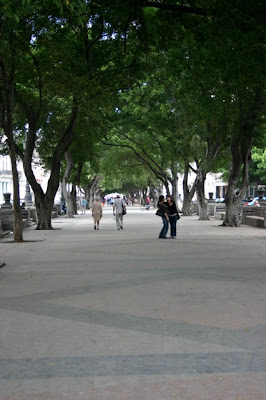WHERE TO TURN 60?
How about Cuba?
Varadero econo all-in I think it was called StalinWorld TM . It wasn’t so bad. Not so much the Gulag as the Village in the old TV show The Prisoner.
Anyway, when the guards weren’t looking you could sneak away; catch a spanking Chinese bus to... La Habana.
With the Lonely Planet as our guide, let’s follow the Centro Habana Architecture Amble.
From Hotel Telegrafo homebase we start where el Prado meets the Malecon. Work began on the Prado in 1770, the ambitious goal being to create a boulevard as grand as any found in Barcelona or Madrid. Our guidebook calls it salubrious. The Spanish godblessthem what with their slaughtering and pillaging and desecrations built some very fine public spaces.
We take our snouts out of the book and look up to see the art deco gem the Teatro Fausto. Live comedy theatre every weekend.
South end of the Prado is our digs the Telegrafo. Across from Parque Central. It’s a Habaguanex hotel. The state outfit that restores and runs hotels in Centro and Vieja (the UNESCO World Heritage site neighbourhood next door). Profits fund ongoing heritage restorations in these neighbourhoods. Numerous references to the legendary City Historian’s Office credited with extensive and often impressive restorations.
Other side of Parque Central is Edificio Bacardi. Here’s Lonely Planet: “Habana’s – and perhaps Latin America’s – most emblematic art deco building, the kitschy Edificio Bacardi, a vivid and highly decorative incarnation of this popular inter-war architectural genre garnished with granite, Capellania limestone and multicoloured bricks.”
On to the flamboyant Gran Teatro de la Habana where “eclecticism meets neobaroque”. Home of the National Ballet of Cuba and the State Opera, it lays claim to being the oldest operating theatre in the western hemisphere. The original Teatro Tacon opened in 1838 with five masked carnival dances.
Two pesos gets you a tour by a flamboyant and eccentric character – six foot two 90 pound redhead, sparkle makeup and polyester bell bottoms – of this spectacular 2000 seat hall.

 Our guidebook encourages us south where ... "few travellers venture, a neighbourhood with some of Habana’s most engaging art nouveau and art deco townhouses. For pure artistic cheek, check out the pink and white wedding cake structure on the corner of Cardenas and Apodaca."
Our guidebook encourages us south where ... "few travellers venture, a neighbourhood with some of Habana’s most engaging art nouveau and art deco townhouses. For pure artistic cheek, check out the pink and white wedding cake structure on the corner of Cardenas and Apodaca."Further along Bolivar a gorgeously ornate apartment building, "...one of Habana’s finest Gaudi-esque buildings."
We wander north through Barrio Chino, Habana’s bustling Chinatown. Lonely Planet says that by 1840 there were 400,000 slaves in Cuba most of them of West African origin. In 1862 the British finally began enforcing the ban on slave trading across the Atlantic. Then, indentured Chinese and Mexican Indian workers were brought in to work the sugarcane plantations. By the 1880’s tens of thousands of Chinese had settled in Cuba.

We emerge from the pedestrian walkway of Barrio Chino onto Av de Italia and one of Habana’s “...zaniest art deco creations, a narrow turreted townhouse with cubelike balconies and sharply defined vertical and horizontal lines.”


We emerge from the pedestrian walkway of Barrio Chino onto Av de Italia and one of Habana’s “...zaniest art deco creations, a narrow turreted townhouse with cubelike balconies and sharply defined vertical and horizontal lines.”
We continue north toward the Malecon and we’re dying of thirst. Cantinas overlooking public squares are plentiful.
On our right the classic 1920’s art deco Teatro America built to house new shops and apartments. The theatre still plays host to vaudeville, comedy, dance, jazz and salsa.
We’re full circle as we approach the “museum of brilliant eclecticism...” that is the Malecon. “The style reaches its apex ... in the faux-Egyptian Centro Hispano Americano de Cultura...” with its gaudy granite gargoyles.And back along the Prado to the Telegrafo and it strikes us what's so distinctive about the Havana traffic symphony. Traffic lights are few and there are no marked pedestrian crossings. The horns don't warn “get out of my way” they are directed at individuals or groups who look like they might be considering heading off the curb and into the street. The horns announce, “if you do, be aware that I'm approaching at a speed which would not let me stop in time... don't say you weren't warned.”









